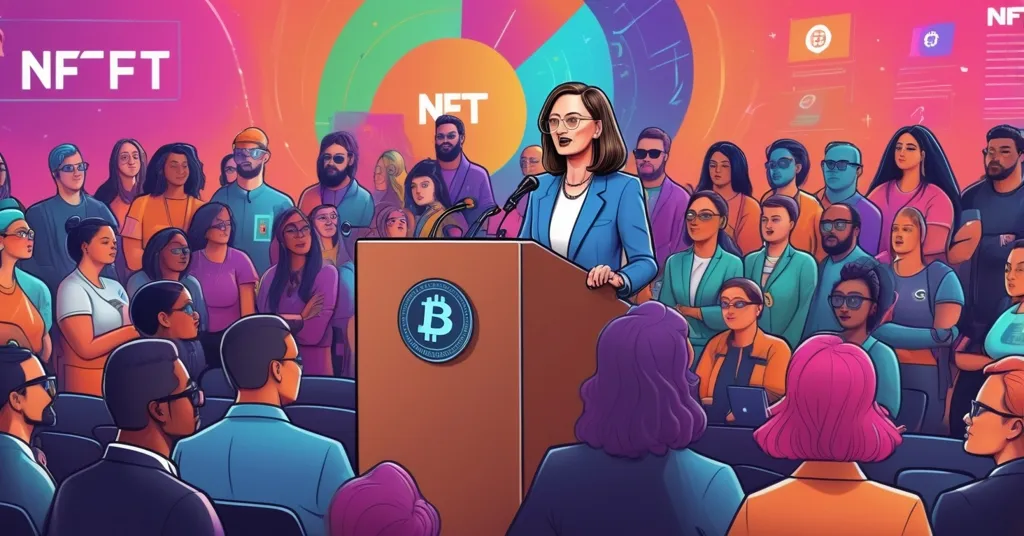SEC’s Crypto Mom Clarifies: Most NFTs, Including Royalty Tokens, Not Securities

SEC’s Peirce Clarifies: Many NFTs Don’t Qualify as Securities, Including Creator-Compensating Tokens
Hester Peirce, affectionately known as “Crypto Mom,” has provided much-needed clarity on the regulatory status of non-fungible tokens (NFTs), sparking hope for clearer guidelines in the crypto world.
- NFTs as non-securities
- Creator royalties and regulation
- SEC’s Crypto Task Force initiatives
Non-fungible tokens (NFTs) are unique digital assets that represent ownership or proof of authenticity of a specific item or piece of content, often leveraging blockchain technology. These tokens have become a popular way for artists to monetize their work, with some NFTs designed to compensate creators with royalties over time through smart contracts, which are self-executing contracts with the terms directly written into code.
At the recent SEC Speaks event, SEC Commissioner Hester Peirce, head of the SEC’s newly established Crypto Task Force, clarified that many NFTs do not fall under the regulatory umbrella of securities. “Many NFTs do not offer the economic rights typical of securities. These include those designed to compensate creators with royalties over time,” Peirce stated, offering a glimmer of regulatory clarity in the often murky world of digital assets.
The establishment of the Crypto Task Force in January 2025 under Peirce’s leadership marks a significant shift towards more defined guidelines for the cryptocurrency sector. The Task Force has been actively engaging with the industry through roundtables and collaborating with lawmakers to shape potential crypto legislation. This proactive approach contrasts sharply with the skepticism towards cryptocurrencies exhibited by former SEC Chairman Gary Gensler.
Peirce’s emphasis on understanding the “economic realities” of digital assets underscores her nuanced approach to regulation. “Understanding the ‘economic realities’ of these assets, rather than simply their form, is crucial to determine their regulatory classification,” she explained. This perspective could pave the way for regulations that foster innovation while safeguarding investor interests.
Despite Peirce’s clarifying statements, the SEC has yet to provide its own official stance on the regulatory status of NFTs, leaving some room for speculation and debate. However, her advocacy for regulations that support the growth of the crypto market while ensuring investor protection is a beacon of hope for those navigating the complex world of digital asset regulation.
While NFTs compensating creators with royalties are seen as non-securities, the broader NFT marketplace has faced its share of scrutiny. For instance, major NFT marketplace OpenSea received a Wells notice—a formal notice of a possible legal action—from the SEC in August 2024 but was later cleared. Legal experts like Oscar Franklin Tan agree with Peirce’s stance, emphasizing that such earnings are more akin to business income than investment income, and thus should not be treated as securities.
As the Crypto Task Force continues its efforts to engage with lawmakers and other federal agencies, as well as international counterparts, we might see the development of more comprehensive and consistent global standards for crypto regulation. This holistic approach could be what the industry needs to thrive in a regulated yet innovative environment.
In a world where digital art and collectibles are becoming increasingly mainstream, understanding the regulatory landscape is crucial. Peirce’s comments offer hope that the SEC is moving towards a more nuanced and supportive framework for NFTs and the broader crypto market.
Key Takeaways and Questions
- What is Hester Peirce’s stance on the classification of NFTs as securities?
Hester Peirce believes that many NFTs, including those that compensate creators with royalties, do not qualify as securities.
- What is the role of the SEC’s Crypto Task Force?
The Crypto Task Force, led by Hester Peirce, aims to provide clearer regulatory guidelines for the cryptocurrency sector, engaging with the industry and lawmakers to develop potential legislation.
- How does Hester Peirce’s approach differ from that of former SEC Chairman Gary Gensler?
Peirce’s approach is more open and engaged with the crypto industry, contrasting with Gensler’s skepticism towards cryptocurrencies.
- Why is understanding the ‘economic realities’ of digital assets important for regulation?
According to Peirce, understanding the economic functions of digital assets is crucial for determining their regulatory classification, rather than focusing solely on their form.
- What is the current status of SEC’s official clarification on the regulatory status of NFTs?
The SEC has not yet provided its own official clarification on the regulatory status of NFTs, leaving some ambiguity in how these digital assets should be regulated.



